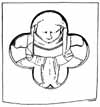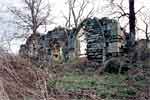For this church:    |
| ||||||
 Demi-effigy Demi-effigy (1931) |
 Demi-effigy Demi-effigy(1931) |
 Cross slab Cross slab(1796) |
'... outside the south door is one complete grave-slab and the head of another, having quatre-foil sinkings containing heads and a pair of hands clasped in prayer, presumably from the tombs of early priests. There is a stone with foliated cross-head lying under the chancel arch. Then there is the stone lying in the nave with the fine cross fleury and shewing traces of an inscription in Gothic lettering. It is now decayed and choked with moss, but Throsby gives this inscription as
Jesu Mercye, Lady helpe,
divided by the arms of the cross, and on the stepped base or "Calvary" a shield of arms having a bend between six cross crosslets for Stanhope, impaling a coat, even then illegible; and below this the legend,
"Orate pro aia Johanne Stanhope uxor henrici Stanhope arm."
Among the nettles in the mortuary chapel is the recumbent effigy of a woman, the head resting on a lozenge shaped cushion, superposed on a square one with tasselled corners. She is represented wearing the wimple or chin veil, so presumably was a "vowess." These were mostly widows of noble or gentle families who took a vow of chastity. This was a formal ceremony usually performed by a bishop, or by an abbot or prior commissioned by the bishop, who invested the vowess with a pall or mantle, a veil, and a ring, and the vow of chastity was taken in a set form of words. Thereafter she could continue to live in her late husband’s castle or manor house, or she might retire into a nunnery—not as a member of the order—but merely as a lodger still free to move about and attend to worldly affairs. Examples of the wording of the vow both in English and French, and a list of the vows recorded at York between 1374 and 1526 will be found at the end of Vol. III. of the Surtees Society’s Testamenta Eboracensia, and therein I find the vow of Elizabeth Stanhope, widow, taken before the archbishop at Scrooby on 19th August, 1459, and that, I take it, identifies the lady whose effigy we see.'
Currently (2019) the larger of the two demi-effigial slabs and fragments of the cross slab remain at the site (see Archaeology section). The smaller demi-effigial slab has been lost. The effigy of a woman has been moved to Walesby church.






